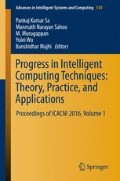Abstract
Hand motion recognition is an interesting field in the development of virtual reality applications through the human–computer interface. The stochastic mathematical model hidden Markov model (HMM) is used in this work. There are numerous parametric efforts in HMM for temporal pattern recognition. To overcome the recursiveness in the forward and backward procedures, dimensionality and storage problem in Markov model, 2-D HMM has been used. The experimental results show the comparison of 2-D HMM with 1-D HMM in terms of performance measures.
Access this chapter
Tax calculation will be finalised at checkout
Purchases are for personal use only
References
Mokhtar M. Hasan and Pramoud K. Misra, Brightness factor matching for Gesture Recognition system using Scaled Normalization, International Journal of Computer Science & Information Technology (IJCSIT), vol. 3, no. 2, April 2011.
Sushmita Mitra and Tinku Acharya, Gesture Recognition: A Survey, IEEE Trans. on Systems, Man, and Cybernetics, Part C: Applications and Review, vol. 37, no. 3, pp. 311–324, 2007.
Mokhtar M. Hasan and Pramoud K. Misra, Robust Gesture Recognition using Euclidian Distance, IEEE International Conference on Computer and Computational Intelligence, China, vol. 3, pp. 38–46, 2010.
Mokhtar M. Hasan and Pramoud K. Misra, HSV Brightness factor matching for Gesture Recognition system, International Journal of Image Processing, Malaysia, vol. 4, no. 5, pp. 456–467, 2010.
P. A. Devijver, Modeling of digital images using hidden Markov mesh random fields, Signal Processing IV: Theories and Applications, pp. 23–28, 1998.
J. Li, A. Najimi and R. M. Gray, Image classification by a two-dimensional hidden Markov model, IEEE Trans. on Signal Processing 48, pp. 517–533, 2000.
D. Schonfeld and N. Bouaynaya, A new method for multidimensional optimization and its application in image and video processing, IEEE Signal Processing Letters 13, pp. 485–488, 2006.
Yuri Grinberg and Theodore J. Perkins, State Sequence Analysis in Hidden Markov Model, grant from the Natural Sciences and Engineering Research Council of Canada (NSERC).
Raman, Himanshu, Study and Comparison of Various Image Edge Detection Techniques, International Journal of Image Processing (IJIP), vol. 3, Issue 1, 2009.
Arindam Misra, Abe Takashi, Takayuki Okatani, Koichiro Deguchi, Hand Gesture Recognition using Histogram of Oriented Gradients and Partial Least Squares Regression, IAPR Conference on Machine Vision Applications, Japan, pp. 479–482, 2011.
Neha V. Tavari, A. V. Deorankar, Indian Sign Language Recognition based on Histograms of Oriented Gradient, International Journal of Computer Science and Information Technologies, vol. 5(3), ISSN: 0975-9646, 2014.
Bobulski. J, Kubanek. M, Person identification system using sketch of the suspect, Optica Applicata, 4(42), pp. 865–873, 2012.
Janusz Bobulski, Comparison of the effectiveness of 1D and 2D HMM in the pattern recognition, Image Processing & Communication, vol. 19, no. 1, pp. 5–12, 2015.
Jai Li, Gray, Robert M., Image Segmentation and Compression using Hidden Markov Model, Springer International Series in Engineering and Computer Science, 2000.
Rabiner. L.R., A tutorial on hidden Markov models and selected application in speech recognition, Proceedings of the IEEE, 77(2), pp. 257–285, 1989.
Bobulski. J, Adrjanowicz. L, Part I. In Artificial Intelligence and Soft Computing, Springer publication, pp. 515–523, 2013.
E. de Souza e Silva, R. M. M. Leao and Richard R. Muntz, Performance Evaluation with Hidden Markov Models, International Federation for Information Processing (IFIP), LNCS 6821, pp. 112–128, 2011.
Author information
Authors and Affiliations
Corresponding author
Editor information
Editors and Affiliations
Rights and permissions
Copyright information
© 2018 Springer Nature Singapore Pte Ltd.
About this paper
Cite this paper
Sagayam, K.M., Hemanth, D.J. (2018). Comparative Analysis of 1-D HMM and 2-D HMM for Hand Motion Recognition Applications. In: Sa, P., Sahoo, M., Murugappan, M., Wu, Y., Majhi, B. (eds) Progress in Intelligent Computing Techniques: Theory, Practice, and Applications. Advances in Intelligent Systems and Computing, vol 518. Springer, Singapore. https://doi.org/10.1007/978-981-10-3373-5_22
Download citation
DOI: https://doi.org/10.1007/978-981-10-3373-5_22
Published:
Publisher Name: Springer, Singapore
Print ISBN: 978-981-10-3372-8
Online ISBN: 978-981-10-3373-5
eBook Packages: EngineeringEngineering (R0)

